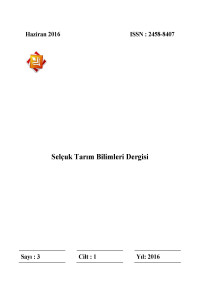Effects of Biopesticide Bacilius Subtilis Qst 713 and Azotobacter Chroococum +Azotobacter Vinelandii Applications on The Table Grape Quality During The Storage Period
Abstract
Gray mold, the most important postharvest disease of table grapes, iscon-trolled by SO2. But, SO2 treatment might be dangerous to people. Thus, this study was conducted to prevent quality loss during storage period of table cv. 'Ekşi Kara' by pre-harvest (24 hours prior to harvest) Bacillus subtilis (Bs), and Azotobacter chroococum + Azotobacter vinelandii (Ac + Av) in Bs 15 ml L-1, Bs 30 ml L-1, Ac + Av 10 ml L-1, Ac + Av 20 ml L-1 in the pro-ducer vineyard. The clusters were transported to storage room (0±1 °C, 85% RH) and put into 500 g paskes. SO2 pad generator and untreated samples utilized as controls. Weight loss (WL), berry and rachis color L, C, h° val-ues, °Brix (%), pH, titratable acidity (TA) in must, maturity index (MI), berry cracking resistance [(CR) (kg)], tensile strength (TS), appearance (0-4 scale), taste (0-4 scale), rachis browning [(RB) (0-4 scale)], decay rate [(DR) (%)] were analyzed. WL at the 75th days of storage period by Bs 15 ml L-1, Bs 30 ml L-1 and Control were 2.63%, 2.63%, 3.93% respectively. Least WL was detected at SO2 3.28% at 105th days of storage. Bs 15 ml L-1, Bs 30 ml L-1, Ac+Av 10 ml L-1, Ac+Av 20 ml L-1, and SO2 applications were found effective on certain quality criteria. Bs 15 ml L-1, stands out in terms of prevention of berry C value, °Brix, RB, TS, CR, taste and appearance; Bs 30 ml L-1, berry C value, °Brix, taste, appearance, pH, MI and DR, and Ac+Av 10 ml L-1, WL, RB, and Ac+Av 20 ml L-1, WL, °Brix, pH, appear-ance, RB values. SO2, WL, pH and appearance, TA and DR. Bs and Ac + Av may be an alternative to SO2 especially for the short-term table grape preservation. Bs 30 ml L-1 and Bs 15 ml L-1 for 2 months or longer table grapes storage to be an alternative to SO2 application together in the quality retention as well as residues problem.
Biopestisit Bacilius Subtilis Qst 713 ile Azotobacter Chroococum + Azotobacter Vinelandii Uygulamalarının Muhafaza Sürecinde Sofralık Üzüm Kalitesine Etkileri
Abstract
kullanılmaktadır. Ancak, SO2 kalıntıları insanlarda alerjik olabileceğinden alternatif hasat sonrası yöntemler denenmektedir. Bu çalışmada, ‘Ekşi Kara’ üzüm çeşidinin hasat sonrasında kalite kayıplarının önlenmesi için Bacillus subtilis (Bs) QST 713 ile Azotobacter chroococum + Azotobacter vinelandii (Ac+Av) karışımı kullanılmıştır Üretici bağında hasat öncesinde yapraklara Bs 15 ml L-1, Bs 30 ml L-1, Ac+Av 10 ml L-1, Ac+Av 20 ml L-1 püskürtmüş ve bir gün sonra salkım örnekleri 500 gramlık poşetlerde muhafaa deposuna (0 ±1 °C, %85 oransal nem) konulmuştur. SO2 jeneratörü ve uygulama yapılmayan örnekler ise kontrol grupları olarak kullanılmıştır. 15 gün arayla örneklerde ağırlık kayıpları (AK), tanede L, C, h°, şırada Brix (%), pH, titre edilebilir asitlik [(TA) (g L-1)], olgunluk indisi (Oİ), tane kabuk yırtılma direnci (YD), saptan kopma direnci (SD), görünüm (0-4 skala), tat (0-4 skala), salkım iskeletinde kararma [(SK) (0-4 skala)], tanelerde çürüme (%) analizleri yapılmıştır. Bs uygulamalarının depolama sürecindeki AK’ına etkileri 75. güne kadar (Bs 15 ml L-1, %2.63 ve Bs 30 ml L-1 %2.63) Kont-rolün (%3.93) altında kalmıştır. En az ağılık kaybı tüm dönemlerde SO2 uygulamalarında belirlenmiştir. Bs ve Ac+Av uygulamaları özellikle kısa süreli sofralık üzüm muhafazasında SO2 uygulamalarına bir alternatif ola-bilme potansiyeli göstermiştir. 2 ay veya daha uzun süreli muhafazada Bs 15 ml L-1 ve Bs 30 ml L-1, SO2 uygulamalarına bir alternatif niteliğinin yanı sıra kalıntı probleminin önlenmesi veya azaltılmasında birlikte uygulanabilir.
Details
| Primary Language | English |
|---|---|
| Subjects | Horticultural Production |
| Journal Section | Research Article |
| Authors | |
| Publication Date | June 25, 2016 |
| Submission Date | January 27, 2016 |
| Published in Issue | Year 2016 Volume: 3 Issue: 1 |
Cite
Selcuk Agricultural and Food Sciences is licensed under a Creative Commons Attribution-NonCommercial 4.0 International License (CC BY NC).


